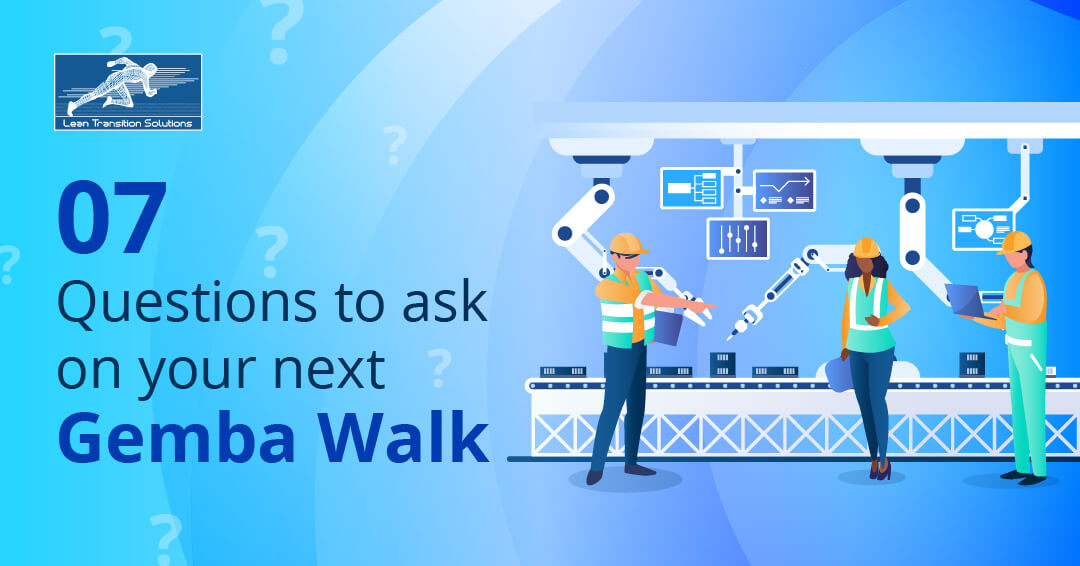7 questions to ask on your next Gemba Walk
August 1, 2023
Continuous improvement is crucial for the success of any organisation. It typically starts by observing shop floor activities and implementing leader standard work. Gemba walks help analyse current processes, identify improvement areas, and set standards for each operational process. Gemba walk is a powerful practice rooted in Lean Management that empowers organisations to unlock the full potential of their processes and engage their workforce in driving meaningful change.
Let us discuss the importance of Gemba walk in Lean management, its fundamental purpose, and the crucial Gemba questions to ask while starting your organisational excellence journey.
What is a Gemba Walk?
The Gemba walk is a management technique from the Lean manufacturing philosophy. In Lean, "gemba" means to visit the actual place where work is being done, whether it's a factory floor, a healthcare setting, or any other operational environment. A Gemba walk involves leaders, managers, or supervisors going to the actual location where the work is being done.
During a Gemba walk, the purpose is to observe, learn, and engage with employees directly involved in the processes. By conducting a Gemba, leaders can gain first-hand insights into how operations are carried out, identify opportunities for improvement, and better understand the challenges the frontline workers face.
Benefits of Gemba Walk in Lean Management
- Real-time understanding of processes
- Identification of inefficiencies and waste
- Continuous improvement opportunities
- Data-driven decision making
- Enhanced problem-solving capabilities
- Improved communication across all levels of the organisation
- Increased operational efficiency and productivity
- Reinforcement of Lean principles and culture.
Preparing for a Gemba Walk
- Setting Clear Objectives and Goals: Before performing a Gemba walk, it's essential to establish specific objectives and goals for the visit. Determine what you want to achieve through the walk, such as identifying process inefficiencies, seeking improvement opportunities, or understanding the challenges faced by the workforce. Clear objectives will guide your focus during the Gemba walk and ensure you gather relevant information to support decision-making processes.
- Identifying Areas to Observe: Choosing specific areas within your organisation to observe is important when planning a Gemba walk. These areas may include a production line, an assembly station, a customer service desk, or any other crucial part of the workflow. By selecting the appropriate area for your Gemba walk, you can effectively acquire valuable insights into the essential processes and use your time on the ground.
- Scheduling the Gemba Walk and Communicating with Team Members: Set a date and time for the Gemba walk that aligns with the availability of key team members to minimise workflow disruptions. Inform the relevant employees and stakeholders about the upcoming Gemba, explaining its purpose and potential benefits. This communication also ensures that everyone is prepared, comfortable, and understands the value of their participation.
The 7 Key Questions to Ask During a Gemba Walk
Asking questions on a Gemba walk is crucial because it fosters active engagement and empowers frontline employees. Gemba walk questions help gather valuable insights and encourage a culture of open communication where employees feel heard and valued.
Through thoughtful questioning, leaders can identify areas of inefficiency, validate assumptions, and make data-driven decisions. Ultimately, asking questions on a Gemba walk paves the way for continuous improvement and strengthens the relationship between management and the workforce.
Question 1: What is the Current Process Flow?
- Understanding the Workflow and Sequence of Activities: By asking this question, we aim to understand the step-by-step process involved in the workflow. This helps identify the various stages, handoffs between team members, and the overall workflow.
- Identifying Potential Bottlenecks and Delays: Through this question, we seek to pinpoint areas where delays or bottlenecks occur. Understanding these obstacles is crucial for eliminating waste, optimising processes and enhancing Overall Operational Efficiency (OOE).
Question 2: Are Standard Operating Procedures (SOPs) Followed?
- Ensuring Adherence to Best Practices and Quality Standards: By inquiring about SOP adherence, we ensure that employees follow established best practices and quality standards. This promotes consistency and helps maintain the desired product or service quality level.
- Addressing Deviations and Implementing Corrective Actions: If there are any deviations from SOPs, asking this question allows us to address the root causes of non-compliance. Identifying and rectifying deviations promptly helps prevent errors, improve process consistency, and implement corrective actions to uphold operational excellence.
Question 3: How does this task or process align with the objectives of this company?
- Ensuring alignment with goals and objectives: By asking this question, we assess whether the task or process directly supports achieving the goals and objectives of the company. It helps to confirm that employees' efforts align with the organisation's strategic direction or True North.
- Seeking Opportunities for Process Improvement: If any misalignments are identified, it opens up opportunities to make adjustments and improve efficiency. This ultimately contributes to achieving the company's goals and objectives.
Question 4: How is Employee Engagement and Motivation?
- Assessing Employee Morale and Satisfaction: By asking this question, we gauge the overall morale and job satisfaction levels of employees involved in the process. Understanding their sentiments helps evaluate the work environment and identify areas for improvement.
- Recognising and Addressing Factors affecting Employee Productivity: This question allows us to identify any factors affecting employee motivation and productivity negatively. Addressing these issues on time can boost employee engagement and motivation, resulting in better performance and higher-quality outcomes.
Question 5: Are Visual Management Tools Utilised Effectively?
- Evaluating the use of Visuals to display information clearly: This question focuses on assessing how well visual management tools are utilised to present critical information clearly and easily. For instance, Kanban boards are an excellent visual management tool to visualise workflows, track progress, and manage tasks efficiently.
- Identifying opportunities to enhance Visual Management: By asking this question, we seek to find ways to improve the utilisation of visual management tools for better communication and decision-making. One such example is the T card scheduling system, where coloured cards with task details are displayed on a board to represent different stages of a project or process. One can identify opportunities to enhance the T card system and optimise task management by evaluating its effectiveness.
Question 6: Are Metrics and Key Performance Indicators (KPIs) Visible?
- Reviewing the Visibility of Performance Metrics: Assessing how well KPIs are displayed and communicated throughout the workspace is important as it directly affects the overall operational activities in your organisation. Having a clear understanding of performance metrics allows employees to track their progress easily and fosters a sense of accountability.
- Ensuring Employees are aware of Targets and Progress: We need to ensure that employees know the targets they need to achieve and how they are progressing towards those goals. Timely updating metrics is essential to provide real-time insights, enabling employees to make informed decisions and take corrective actions.
Question 7: What Suggestions do Employees have for Improvement?
- Encouraging Employee feedback ideas: This question aims to actively engage employees in improving by inviting their valuable feedback and ideas. Creating an open and supportive environment where employees feel comfortable sharing their suggestions fosters a culture of collaboration and innovation.
- Promoting a Culture of Continuous Improvement: You can emphasise the importance of ongoing improvement efforts by asking this question. Actively seeking and implementing employee suggestions demonstrates a commitment to continuous growth and development, leading to a more agile and adaptive organisation.
Leader Standard Work and Gemba Walks
A good Gemba walk leader possesses qualities like active listening, approachability, and a genuine interest in understanding the frontline employees. They foster a culture of open communication, encouraging employees to share their insights and suggestions freely. During the Gemba walk, the leader engages with employees, recognising their contributions and addressing their concerns. This fosters employee engagement and creates a sense of ownership in the improvement process.
Additionally, the leader is diligent in capturing observations and gathering data about the current processes. They identify improvement areas and establish follow-up actions to address any identified issues. By integrating Leader Standard Work into the Gemba walk process, leaders drive meaningful change and set a standard for continuous improvement and employee empowerment.
Gemba Walk Best Practices
- Observe Non-Judgmentally: Interact with employees on the Gemba with empathy and respect. Listen actively to their experiences, challenges, and suggestions to foster a culture of open communication and trust. Observe processes and activities without passing judgement. A non-judgmental approach encourages employees to be more transparent about their challenges.
- Visual Management: Pay attention to the visibility and effectiveness of visual management tools such as Kanban boards or T cards. Ensure that these tools are up-to-date and effectively convey relevant information.
- Document Findings: Take detailed notes during the Gemba walk to document observations, suggestions, and deviations from standard procedures. These notes will serve as valuable references for follow-up actions.
- Follow-up and Accountability: Implement a system to track and follow up on identified improvement opportunities. Assign responsibilities and hold individuals accountable for executing action plans.
- Share Learnings: Share the learnings and outcomes of Gemba walks with the entire team and organisation. Transparently communicating the findings promotes knowledge sharing and encourages collective improvement efforts.
Gemba Walk stands as a cornerstone practice in Lean Management, offering an invaluable opportunity for leaders to connect with their frontline workforce and gain real-time insights into operational processes. Leaders can gain a deeper understanding of daily operations, identify inefficiencies, and discover opportunities for process optimization by immersing themselves in the actual workplace. Moreover, the Gemba Walk empowers employees, who feel valued when their opinions are sought, leading to increased engagement and collaborative culture.
When leaders ask insightful questions during a Gemba walk, they gain a deeper understanding of the strengths and weaknesses of different operational processes. This knowledge helps them make informed decisions based on data and implement specific improvements. Through open communication and active listening, leaders can foster a culture of continuous improvement where employees are encouraged to share their ideas.
The Gemba Walk is more than a mere management tool; it is a powerful catalyst for driving continuous organisational improvement. As leaders embrace this practice sincerely and commit to regular engagement with their teams, they ignite a culture of transparency, trust, and progress. The Gemba Walk is a crucial aspect of Lean Management that fosters a shared sense of purpose and collective drive for excellence within an organisation. Companies can succeed in a constantly changing business environment through this simple yet revolutionary practice.
